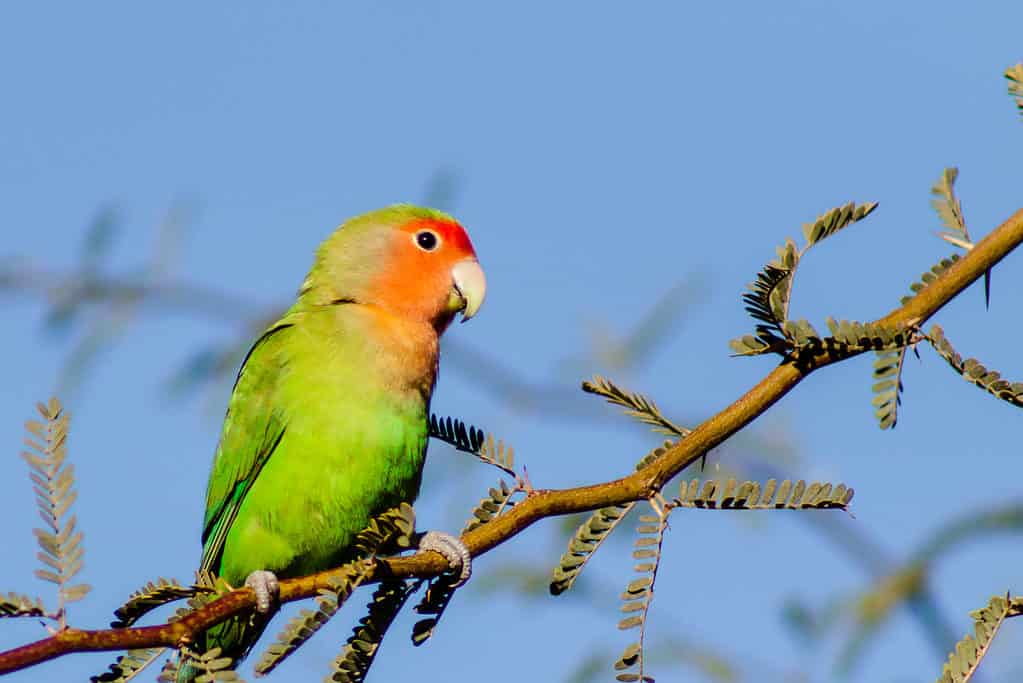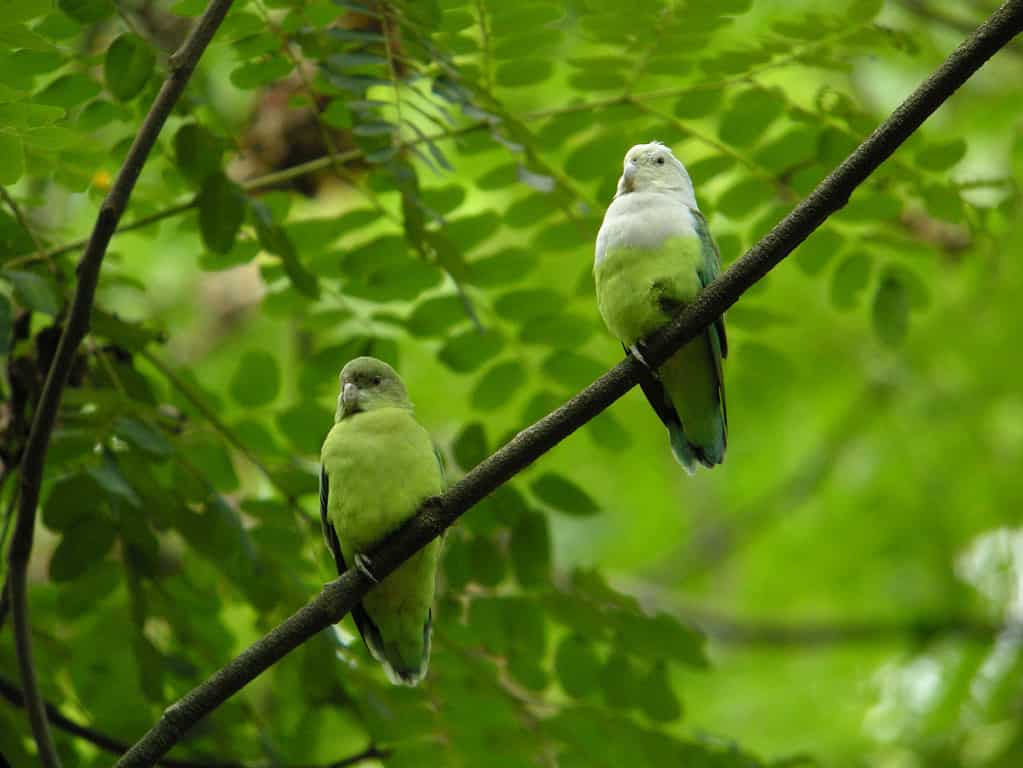Lovebirds, also known as “pocket parrots,” are one of the smaller members of the parrot family. The scientific name for the lovebird is Agapornis. Lovebirds, native to the African continent, are popular as companion pets. They are known for their beautiful coloring, intelligence, and friendly nature.
Read on to discover all types of lovebirds, including where they live, what they eat, and how they behave.
1. Peach-Faced Lovebird

Peach-faced lovebirds are the most common type of lovebird that people keep as pets.
©South O Boy/Shutterstock.com
Also known as rosy-faced, peach-faced lovebirds are the most common type of lovebird that people keep as pets. Their distinctive rosy, or orange-colored cheeks are probably what comes to mind when you think of lovebirds.
Although this friendly and colorful bird is native to Africa, flocks of peach-faced lovebirds have been seen flying wild in Arizona. A flock of pet bird escapees was documented living in Phoenix in the 1980s. Today, the number of peach-faced lovebirds living freely within the city limits is estimated to be over 2,000.
Scientific Name: Agapornis roseicollis
Native Habitat: Southwest Africa
Size: 7 to 8 inches from head to tail tip; weight under 2 ounces
Diet: Seeds, berries, leaves
2. Nyasa or Lilian’s Lovebirds

The Nyasa lovebird is seldom found in captivity due to challenges in breeding.
©David Herraez Calzada/Shutterstock.com
The Nyasa lovebird is the rarest of the species. Seldom found in captivity due to challenges in breeding, less is known about this type of lovebird than the other species.
With mostly green feathers, these little parrots have orange foreheads and throats. The color turns to a salmon-pink on the face and top of their heads. At around five inches from head to tail, the Nyasa lovebird is one of the smaller of the lovebirds.
Scientific Name: Agapornis lilianae
Native Habitat: Zimbabwe, Zambia, Tanzania, and Malawi
Size: 5.4 inches from head to tail tip; weight between 1 to 1.3 ounces
Diet: Grass, fruit, seeds
3. Madagascar or Grey-Headed Lovebirds

Madagascar lovebirds are the only type of lovebird that lives on the island of Madagascar.
©Frank Vassen / Flickr – License
Native to the rainforests of Madagascar, these are the smallest of the lovebird species. Madagascar lovebirds are the only type of lovebird that lives on the island of Madagascar.
It’s easy to tell the difference between males and females of this species as they look a bit different. The females have green plumage with darker shades on their wings and back. The males have the same green on their lower bodies, while their upper bodies and heads are a pale grey.
Scientific Name: Agapornis cana
Native Habitat: Madagascar rainforest
Size: 5 inches from head to tail tip; weight between 1 to 1.25 ounces
Diet: Grass, leaves, bark, small insects
4. Black-Cheeked Lovebirds

Black-cheeked lovebirds are the most endangered of the lovebird species.
©iStock.com/Akatjomar
Sadly, the black-cheeked lovebird is considered the most endangered of the lovebird species. Although not technically endangered, the birds are listed as a “vulnerable species” due to population decline from loss of habitat.
Black-cheeked lovebirds have mainly green feathers with black faces, white rings around their eyes, and bright red beaks. While young black-cheeked lovebirds are duller in color with a more orangish-colored beak.
Scientific Name: Agapornis nigrigenis
Native Habitat: Southwest Zambia
Size: 5.5 inches from head to tail tip; weight about 1.4 ounces
Diet: Seeds, grass, leaves
5. Black-Masked or Yellow-Collared Lovebirds

The black-masked (or yellow-collared) lovebird,
Agapornis personata, has a bright red beak and a distinctive yellow collar.
©Diego Tirira / Flickr – License
Not to be confused with the black-cheeked lovebird, the black-masked (or yellow-collared) lovebird is another type of lovebird people enjoy keeping as pets. They are reported to be less aggressive and calmer to keep as companions than the popular peach-faced lovebirds.
These colorful birds have black heads with white rings around their eyes. Additionally, they have bright red beaks and a distinctive yellow collar, which fades to green along the rest of their bodies.
Scientific Name: Agapornis personata
Native Habitat: Northeast of Tanzania
Size: 5.5 inches from head to tail tip; weight around 1.7 ounces
Diet: Seeds, nuts, fruits, berries
6. Black-Collared or Swindern’s Lovebird
You won’t find a black-collared lovebird kept as a pet because this little bird requires a native fig seed or fig flesh as part of its daily diet. Indeed, without its native fig, the black-collared lovebird will not thrive in captivity.
This rare species wasn’t discovered until 1820, perhaps because the species is shy and tends to hide above the forest canopy. The black-collared lovebird has mainly green feathers and a distinctive black collar at its neck.
Scientific Name: Agapornis swindernianus
Native Habitat: Equatorial Africa
Size: 5 inches from head to tail tip; weight around 1.4 ounces
Diet: Fig seeds, fig flesh, rice
7. Black-Winged or Abyssinian Lovebird

The black-winged lovebird is the largest of its species, preferring to live at high altitudes.
©Eckhard Lietzow/Shutterstock.com
The black-winged lovebird is the largest of its species. They prefer living at very high altitudes and tend to nest in trees. Both males and females have mainly green feathers. You can tell the males and females apart by the color of the underside of their wings. The 2113594832
Black-winged lovebirds require roomy cages where they can fly from one perch to another. Because of this, they are not commonly kept as pets. Further, they may turn aggressive or injure themselves if kept in cramped spaces.
Scientific Name: Agapornis taranta
Native Habitat: Mountains of Southern Eritrea, southwestern highlands of Ethiopia
Size: 6 to 6-1/2 inches from head to tail tip; weight from 1.6 to 1.9 ounces
Diet: Fruit, vegetables, figs
8. Fischer’s Lovebird

Fischer’s lovebirds have vibrant colors regardless of gender and sometimes may have blue or purple tail feathers.
©Danita Delimont/Shutterstock.com
This gorgeous little lovebird was discovered in the 19th century and named after its discoverer, Gustav Fischer. The males and females look alike with vibrant, colorful feathers. Also, they sometimes may have blue or purple tail feathers with bright green bodies. Their necks and faces are golden yellow to orange colored, with a bright red beak, and olive green head.
These energetic, friendly, little birds are commonly kept as pets.
Scientific Name: Agapornis fischeri
Native Habitat: Tanzania
Size: 5 to 6 inches from head to tail tip; weight up to 2 ounces
Diet: Seeds, fruits, grains
9. Red-Faced Lovebirds
Red-faced lovebirds do not do well in captivity. This is because they have specific nesting habits which make it difficult for them to breed or thrive as pets. The birds like to burrow to nest. Also, the nest must be kept at a warm 80 degrees Fahrenheit. This breeding requirement makes it hard for the average pet owner to replicate.
The red-faced lovebirds are gorgeous birds with green plumage on their bodies, tails, and necks. Additionally, they sport a soft peach-orange color on their faces and forehead.
Scientific Name: Agapornis pullaria
Native Habitat: Rainforests of equatorial Africa
Size: 6 inches from head to tail tip; weight up to 1.5 ounces
Diet: Seeds, fruits, grains
The photo featured at the top of this post is © irakite/Shutterstock.com
Thank you for reading! Have some feedback for us? Contact the AZ Animals editorial team.






